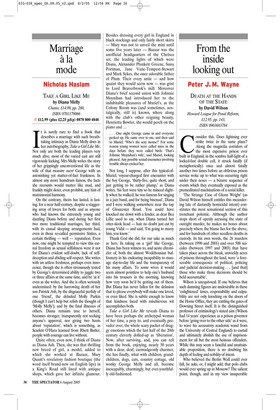Marriage à la mode
Nicholas Haslam
TAKE A GIRL LIKE ME by Diana Melly Chatto, £14.99, pp. 280, ISBN 0701179066 ✆ £12.99 (plus £2.25 p&p) 0870 800 4848 It is surely rare to find a book that describes a marriage with such breathtaking intimacy as Diana Melly does in her autobiography, Take a Girl Like Me. Not only are both the leading players very much alive, most of the varied cast are still vigorously kicking. Mrs Melly writes the story of her grippingly unconventional life as the wife of that monstre sucré George with an astonishing yet matter-of-fact frankness. In almost any more humdrum liaison, the facts she recounts would matter like mad, and frankly might deter, even prohibit, any hint of matrimonial harmony.
On the contrary, theirs has lasted, is lasting, for a near half-century, despite a staggering array of lovers for both; and as anyone who had known the extremely young and dazzling Diana before and during her first two more traditional marriages, her third, with its casual sleeping arrangements had, even in those so-called permissive Sixties, a certain thrilling — well — reputation. Even now, one might be tempted to view this carnal freedom as sexual selfishness were it not for Diana’s evident self-doubt, lack of selfdeception and abiding self-respect. She writes with an artless freshness, perhaps even innocence, though she is often strenuously tested by George’s determined ability to juggle two or three affairs at the same time, and be ‘at it’ even as she writes. And she is often seriously undermined: by the harrowing death of her son Patrick Ash, by the disgraceful perfidy of one ‘friend’, the deluded Molly Parkin (though I can’t help but relish the thought of ‘Molly Melly’), and by the fatal illnesses of others. Diana remains true to herself, becomes stronger, transparently not seeking anyone’s approval, nor giving two hoots about ‘reputation’, which is something, as Scarlett O’Hara learned from Rhett Butler, people with courage can live without.
Quite often, even now, I think of Diana as Diana Ash. Then, she was that thrilling new breed of girl, a model, added to which she worked at Bazaar, Mary Quant’s revelatory fashion boutique (the word itself brand-new on English lips) in a King’s Road still lined with antique shops, which gave her infinite glamour. Besides dressing every girl in England in black stockings and only fairly short skirts — Mary was not to unveil the mini until some five years later — Bazaar was the unofficial headquarters of the Chelsea set, the leading lights of which were Diana, Alexander Plunkett Greene, Suna Portman, Jane Vane-Tempest-Stewart and Mark Sykes, the once adorable father of Plum. Their every antic — and how quaint they would seem now — was grist to Lord Beaverbrook’s mill. Moreover Diana’s brief second union with Johnnie Moynihan had introduced her to the indubitable pleasures of Muriel’s, as the Colony Room was (and sometimes, nostalgically, still is) known, where along with the club’s other reigning beauty, Henrietta Bowler, she would perch on the piano and ...
. . . One night George came in and everyone perked up. He came over to me, and then said to Muriel, ‘Who’s the sexy mouse?’ For some reason young women were called mice in the days before they were called birds. ‘That’s Johnnie Moynihan’s wife’, said Muriel, looking pleased. Any possible sexual encounter involving trouble always excited her.
Not long, I suppose, after this typical-ofMuriel, voyeur-charged first encounter with the boy George, ‘thirty-five, quite short, and just getting to be rather plump,’ as Diana writes, ‘his feet were tiny so he minced slightly when he walked; he was famous for singing in a jazz band, and for being bisexual’, Diana and I were walking somewhere near the top of Gloucester Road. You could have knocked me down with a fender, as dear Bea Lillie used to say, when Diana turned her otter-sleek head — hair no doubt just cut by young Vidal — and said, ‘I’m going to marry him, you know.’ Thank God she did, for our sake as much as hers. In taking on a ‘girl’ like George, Diana has been witness to, and acute chronicler of, both the almost Wodehousian buffoonery in his endearing incapability to manage day-to-day life and the transparency of his many affairs. To some wives it would seem almost pointless to help one’s husband into his trousers in the morning, knowing how very soon he’d be getting out of them. But Diana has never fallen for the delusion that to please everybody will make one loved, or even liked. She is subtle enough to know that kindness laced with mischievous wit accomplishes both.
Take a Girl Like Me reveals Diana to have been perhaps the archetypal woman of her time, a prey to, and eventually prevailer over, the whole scary packet of druggy emotions which the last half of the 20th century cleverly dolled-up as ‘liberation’. Now, after surviving, and, you can tell from the book, enjoying, nearly 50 years with a dear, deaf, curmudgeonly charmer, she has finally, what with children, grandchildren, dogs, cats, country cottage, old wonky George Melly and all, become inescapably, charmingly, but ever-youthfully old-fashioned.











































 Previous page
Previous page